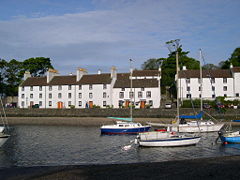Cramond
| Cramond | ||
|---|---|---|
| The port of Cramond | ||
| Coordinates | 55 ° 58 ′ N , 3 ° 18 ′ W | |
|
|
||
| administration | ||
| Post town | EDINBURGH | |
| ZIP code section | EH4 | |
| prefix | 0131 | |
| Part of the country | Scotland | |
| Council area | Edinburgh | |
| British Parliament | Edinburgh West | |
| Scottish Parliament | Edinburgh Western | |
Cramond is a village on the outskirts of Edinburgh in Scotland that is now one of the suburbs of Edinburgh . It is on the northwest end of town at the confluence of the River Almond and the Firth of Forth .
Evidence of early settlement from the Mesolithic , Bronze and Roman times has been found in the area of Cramond . The village is also the birthplace of the Scottish economist John Law .
etymology
It was long believed that the Romans named their fortification Alaterva . A stone altar dedicated to the "Alatervan Mothers and the Mothers of Parade Ground" was found under the foundation of Cramond House. Archaeologists interpreted the inscription as a reference to the site, but this theory is considered disproved by scientists. "Alatervae" is probably an old name for the Matronae Alaterviae .
history
Stone age
Archaeological excavations in the Cramond area have revealed evidence of settlement dating from around 8500 BC. Found. This makes Cramond the oldest known prehistoric settlement in Scotland. The inhabitants of the Mesolithic camp were nomadic hunters and gatherers. All of the bones were decomposed from the acidic soil, but garbage and storage pits and numerous hazelnut shells were found. It is believed that the site was chosen because of its proximity to the River Almond and the Firth of Firth, as the oyster and mussel stocks there provided a reliable source of food. In addition, some microlithic stone tools made at the camp site were found.
Roman times
Roman forces came to Cramond around the year 142. They were commanded by Emperor Antoninus Pius, who had given them the job of building a fort at the mouth of the River Almond. This camp was intended to protect the eastern flank of the border with Scotland. Almost five hundred people worked on it and built a fort that covered nearly 24,281 square meters and a harbor. However, the fort was only inhabited for about fifteen years before the troops left, as they were needed in the south to protect Hadrian's Wall. Pottery and coins from later times show that the fort and port were repopulated between around 208 and 211 and used as a base for the army and fleet of Emperor Septimius Severus.
swell
- Cramond Heritage Trust: Cramond . Cramond Heritage Trust, Edinburgh 1996, ISBN 0-9514741-3-8 .

